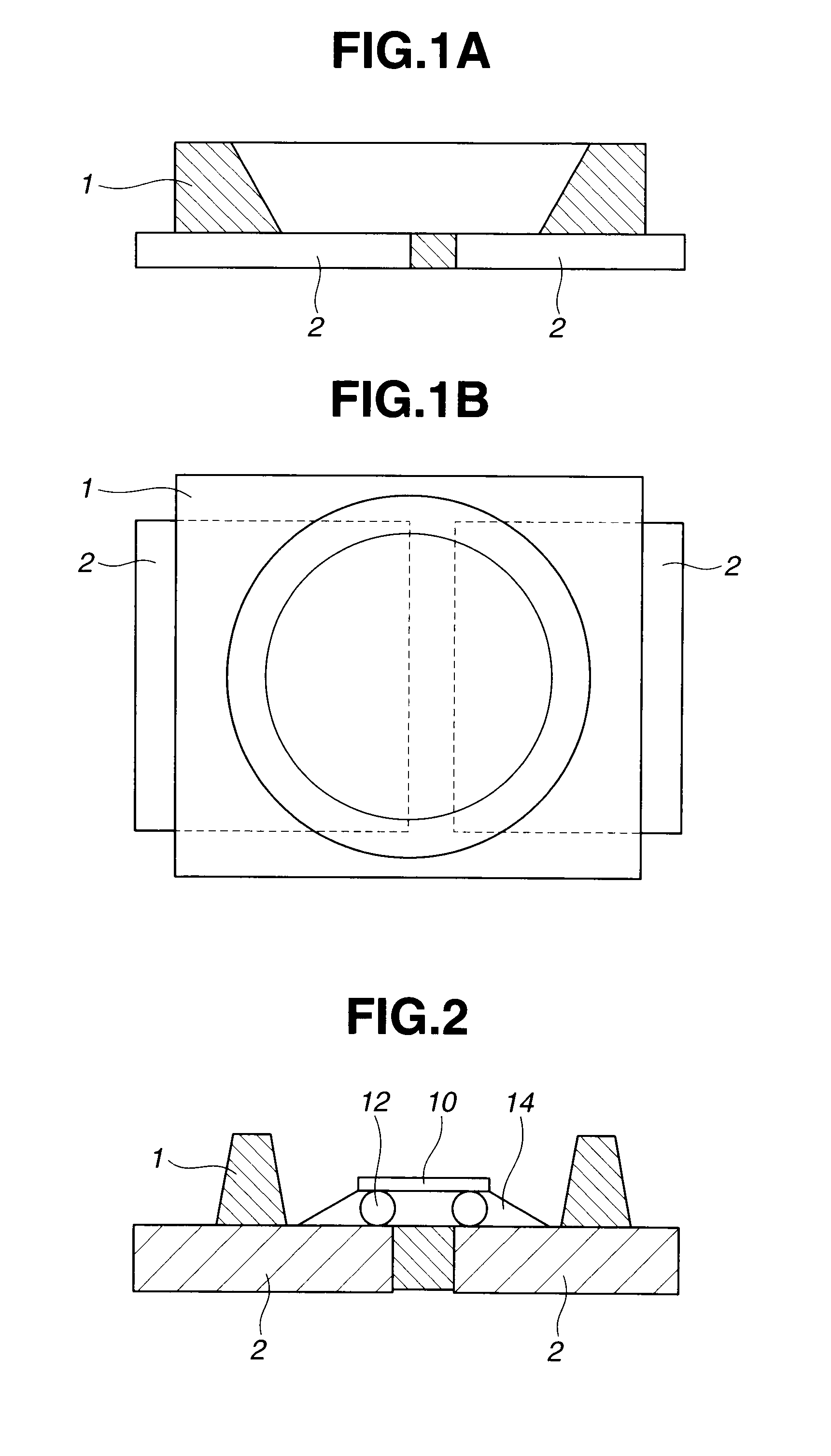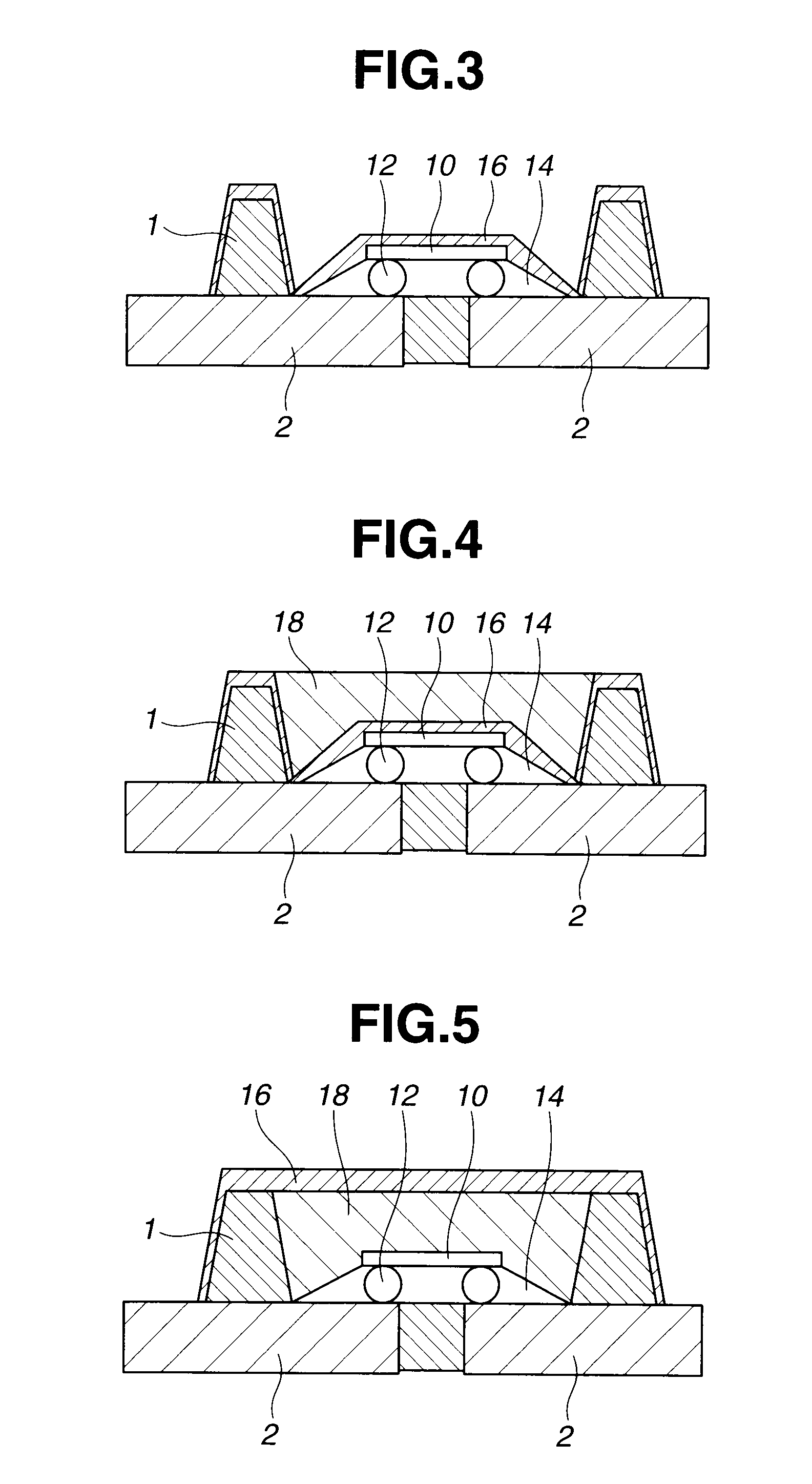Light-emitting semiconductor device, mounted substrate, and fabrication method thereof
a technology of semiconductor devices and substrates, applied in semiconductor devices, semiconductor/solid-state device details, electrical devices, etc., can solve the problems of reducing the service life of chips, weak against light and heat, discoloration and degradation of epoxy resins, etc., to prevent the reduction of reflector reflectance and corrosion, improve gas transmission resistance, and prolong the effect of service li
- Summary
- Abstract
- Description
- Claims
- Application Information
AI Technical Summary
Benefits of technology
Problems solved by technology
Method used
Image
Examples
example 1
[0121]On a reflector molded with a thermosetting silicone resin composition (“SWC7200T,” trade name, product of Shin-Etsu Chemical Co., Ltd.) and having the structure of FIGS. 1A and 1B, a blue LED was held in place with a silicone-based die bonding material (“KJR-632DA-1,” trade name, product of Shin-Etsu Chemical Co., Ltd.). By heating at 150° C. for one hour, the blue LED was fixed on a die pad.
[0122]Subsequently, the blue LED and lead electrodes were electrically connected together via gold wires (FIG. 6). A silicone resin composition, which had been prepared by adding a YAG phosphor at 5 wt % to a transparent silicone resin composition (“LPS-3410,” trade name, product of Shin-Etsu Chemical Co., Ltd.), was then poured into-a recessed part of the reflector by potting. The silicone resin composition was heated and cured at 120° C. for one hour and further at 150° C. for two hours to encapsulate the blue LED.
[0123]The resulting light-emitting semiconductor device was spray-coated w...
example 2
[0125]On a reflector molded from the thermosetting silicone resin composition (“SWC7200T,” trade name, product of Shin-Etsu Chemical Co., Ltd.) and having the structure of FIGS. 1A and 1B, a blue LED was connected via gold bumps as shown in FIG. 2. After the connection, the transparent silicone resin composition (“LPS-3410,” trade name, product of Shin-Etsu Chemical Co., Ltd.), which contained 50 wt % of spherical silica of 5 μm in average particle size, was poured into a gap between the blue LED and a lead frame, and was then cured at 120° C. for one hour. After the silicone resin composition had cured, a 25 wt % solution of perhydropolysilazane (“AQUAMICA”) in tetrabutyl ether was poured into a recessed part of the reflector, followed by curing at 180° C. for 30 minutes. Subsequently, the perhydropolysilazane solution was poured again, and perhydropolysilazane was cured at 180° C. for one hour such that a crack-free, transparent, cured silicon oxide film was formed with an average...
example 3
[0126]Using a light-emitting semiconductor device fabricated in a similar manner as Light-emitting semiconductor device No. 3, the same addition curable silicone resin composition as in Example 1 was poured into a recessed part of a reflector by potting, and was then heated and cured at 120° C. for one hour and further at 150° C. for two hours to encapsulate the light-emitting semiconductor device (FIG. 4). The resulting light-emitting semiconductor device was provided as Light-emitting semiconductor device No. 4.
PUM
 Login to View More
Login to View More Abstract
Description
Claims
Application Information
 Login to View More
Login to View More - R&D
- Intellectual Property
- Life Sciences
- Materials
- Tech Scout
- Unparalleled Data Quality
- Higher Quality Content
- 60% Fewer Hallucinations
Browse by: Latest US Patents, China's latest patents, Technical Efficacy Thesaurus, Application Domain, Technology Topic, Popular Technical Reports.
© 2025 PatSnap. All rights reserved.Legal|Privacy policy|Modern Slavery Act Transparency Statement|Sitemap|About US| Contact US: help@patsnap.com



